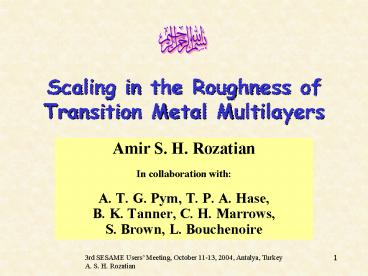Scaling in the Roughness of Transition Metal Multilayers - PowerPoint PPT Presentation
1 / 30
Title:
Scaling in the Roughness of Transition Metal Multilayers
Description:
Scaling in the Roughness of Transition Metal Multilayers. Amir S. H. Rozatian ... Perpendicular Anisotropy in Co/Pd Multilayers, ... – PowerPoint PPT presentation
Number of Views:49
Avg rating:3.0/5.0
Title: Scaling in the Roughness of Transition Metal Multilayers
1
Scaling in the Roughness of Transition Metal
Multilayers
- Amir S. H. Rozatian
- In collaboration with
- A. T. G. Pym, T. P. A. Hase,
- B. K. Tanner, C. H. Marrows,
- S. Brown, L. Bouchenoire
2
Acknowledgments
- Durham University, UK X-ray and Magnetism Group
- Leeds University, UK Prof. B J Hickey and his
group - Isfahan University, IRAN Department of Physics
- SRS, Station 2.3, Daresbury, UK
- ESRF, XMaS Beamline (BM 28), Grenoble, France
- Organizers of the 3rd SESAME Users Meeting
3
Aims
- To study the in-plane and out-of-plane
correlation lengths and scaling behaviour of the
conformal interface roughness of sputtered Co/Pd
and Co/Ru multilayers.
4
Outline of Talk
- 1_ Introduction
- 2_ Theoretical Models KPZ and TAB models
- 3_ GISAXS and MAR CCD techniques
- 4_ Results
- 5_ Conclusions
- 6_ Future Work
5
Introduction
6
Evolution of the Interface Morphology
- The evolution of the interface morphology during
the growth of thin films and multilayers has a
major impact on the overall magnetic and
transport properties. In particular, the
mechanism of roughness propagation from the
substrate to the surface has been the focus of a
number of experimental and theoretical studies.
7
Roughness Profile
Zero roughness
8
Theoretical Models
9
TAB Model
- Huygens Principle
- Columnar Structure
- Longer spatial
- wavelengths
- propagate more easily
Tang C, et al, Phys. Rev. Lett. 64 (1990) 772
10
Parameters of a surface
?3
?1
?2
y1
y2
x2
x1
For a self-similar surface
11
KPZ model
- The variation of the local height of the surface
H(x,t) - Interfacial tension
- Tends to smooth the interface, for
M. Kardar, G. Parisi, and Y. C. Zhang, Phys. Rev.
Lett., 56 (9), 889-892 (1986).
12
KPZ model
Partially correlated system
Uncorrelated system
13
KPZ model
14
Magneto-Optical Disc (MOD)
- Writing The disc is heated locally by a pulse
of a diode laser beam which is focused to a spot
of about 1 ?m. The magnetization is reversed only
in the area of the heated spot by applying a
small field, which is smaller than the coercive
field of the MO layer at room temperature but
larger than the coercive field in the heated
area. - Reading The same laser reads back the written
bits making use of the polar MOKE.
1 MOD? 500 DVD
15
Experimental Techniques (determining roughness)
SR or Lab?
Do we have to take all samples to a 3rd
generation SR?
16
X-ray Data Collection
Intensity
? ? h
Scattering vector
17
GIXR and GIXS data and Simulations for Co/Pt
Multilayers (using BEDE software)
Fulthorpe et al, J. Phys. C., 11(43), (1999)
p8477 Rozatian et al, J. Mag. Magn. Mater. Vol.
256 (1-3), (2003) p365
18
MAR CCD detector
19
Comparison of CCD to conventional detector
20
Results
21
Co/Pd system(GIXR and GIXS results)
22
Co/Pd multilayers(Relation between the
out-of-plane correlation length and N)
- High frequency components of roughness do not
propagate well through Co/Pd layers. - Low frequency components of the conformal
roughness propagate well with a much longer out
of plane correlation length.
The out-of plane correlation length of the
conformal roughness in Co-Pd multilayers,
submitted to Physica B.
23
Co/Pd multilayers(Relation between the in-plane
correlation length and N)
- Scaling behaviour is observed in all the Co/Pd
multilayers. - Reasonable agreement with the TAB and KPZ models
of film growth. - Both approaches show that as the number of
bilayer repeats increases, the interfaces become
more two dimensional in character, as the Hurst
fractal parameter h rises.
The in-plane Length Scale of the Conformal
Interface Roughness as a function of Bilayer
Repeat Number in Co/Pd Multilayers, submitted
to Journal of Physics D.
24
Co/Pd multilayers(Relation between Keff and h)
- h?1 ? Higher Keff
The Relationship between Interface Structure,
Conformality and Perpendicular Anisotropy in
Co/Pd Multilayers, submitted to Journal of
Magnetism and Magnetic Materials.
25
FWHM of 1st Bragg sheet for 15-bilayer Co/Ru
sample (MAR CCD data)
26
Intensity of the first Bragg sheet for 15-bilayer
Co/Ru sample (MAR CCD data, integrated in qz)
27
General Conclusions
- SR methods of determining h, ? , and ?.
- MAR CCD allows the data to be collected in very
little time (but time consuming to analyse).
28
Future Work (could be carried out at SESAME),
(using GIXR and GIXS techniques)
- Study of the magnetic multilayer thin films, spin
valves, GMR devices in magnetic recording
industry, Nano systems, Quantum dots, Lamellar
structures, liquid surfaces, breast cancer, - Theoretical models
- Computational modelling of the x-ray data
29
SAXS Patterns from Different Breast Tissue Samples
Medical Applications of Synchrotron Radiation,
P. Suortti and W. Thomlinson, Phys. Med., Bio.,
48, (2003) R1
30
Thank you for your attention































